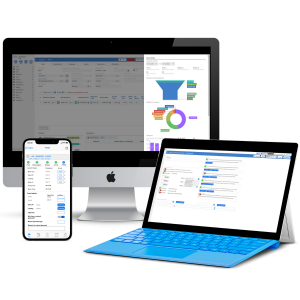What’s the most common driver that is causing customers to change their software?
Aviation software becomes intrinsic with the operational process and customers invest a lot of their time and money into adopting the right product for their operations at a point in time. However, those requirements change, and it is important that products move and adapt at the same pace. A lot of software in the market is sold as a point solution and the user doesn’t have a mechanism to engage with the product team and feel like they are being listened to. They are not seeing the agility of product updates that is needed. Often there is either no roadmap or a promised roadmap which does not deliver the features that were committed to, or the vendor is no longer focused on the areas that are important to that customer. Additionally, technology advancements move at a rapid pace, it’s important that the product is updated regularly to utilize the current state-of-the-art that can drive efficiency and capability into the organization.
How do you approach onboarding to minimize risk and reduce effort for the customer
We understand that a key part of selecting a new software solution is the consideration of how current operational process and historical data can be made available in the new system. As well as this ensuring the solution is configured to match the operational imperatives are key. When customers choose our solution, they are assigned a named solution consultant from our team that comes from an experienced end-user position and has worked across a number of other customer types. They form a team with the customer ensuring everything in the transition process runs smoothly, no generic email addresses or faceless resources, but a consistent knowledgeable person who is as focused on achieving your required outcomes. As part of this solution, we have built proven data migration pipelines that can seamlessly move data from your existing service provider to your new myairops cloud environment. We want to work with you to ensure you’re getting the maximum potential out of your product. During reference calls with current customers, we are frequently told we are a partner who listens, and we act and advise to our customer’s needs and this focus on both on-boarding and after-sales support is a huge differentiator.
What do you really mean by cloud-based software?
Here at myairops, we have built some of the most modern cloud capabilities that exist in the aviation market today. We have partnered with the Microsoft Cloud as their global data center locations means we have deployments around the , and we are able to offer data sovereignty & privacy to ensure data remains where its required. Furthermore, this global scale means we can achieve levels of availability where downtime is a thing of the past and organizations do not need to worry about the Business Continuity and Disaster Recovery aspects of their aviation services as this is all included within the service. With a focus on security, we are audited to the SOC2 standard and offer integration with the customer’s cyber security policy supporting single sign-on (SSO), MFA and CREST approved independent security penetration testing.
Cloud is often misunderstood. Our solutions are available through the web browser. This means they are accessible from anywhere. This also removes the need for specialist connections, hardware or even the confines of an office location. It does not matter if you use a Windows or Mac environment, and everything becomes linked. Even reports that were once static can contain links taking you to the relevant data in our systems.
We also provide an unprecedented level of access to data and provide the ability for our customers to integrate with our software though interfaces which allow developers and data engineers the ability to integrate with our products.
Businesses and operators can be very different. How do you support tailoring and customization?
From our experience, we understand that businesses and operators are very different from each other, and it is important to their success that their software is tailored to meet their needs. We have many different operator types who use different parts of our system in different ways.
We offer configurable workflows through our product and role-based segregation meaning that the system can be adapted to meet the differing needs of an operation. A Part-135 operations does not need to worry about SIFL personal use tax calculations so their environment will not contain it. This is a very simple example of how our system can be configured.
Our approach to providing functionality through version-controlled APIs and our developer portal has allowed us to build custom workflows and tools around your requirements. An example of this is a major corporate flight department has built a shuttle management tool allowing staff to book seats on shuttle flights and place demand directly into our system. And another Part-135 has integrated a dead head sales and availability checking solution from their marketplace.
Many organizations have task lists that underpin their operation. Whether that is performing actions pre-departure, charter sales quoting, or handling post flight information and feeding into maintenance workflows. These steps are important, and we do not think there is just one way to do things. To deal with this variation we have a fully customizable task engine that allows you to configure any task list against any specific action, team, person etc. It is also intelligent enough to respond to change, it’s dynamic and updates in real time.
What does a software company know about aviation?
Our team is made up of aviation experts. We are not just comprised of software engineers and technologists that have tapped into the aviation market or trying to apply generalist software to a specialist requirement. We provide trip support services ourselves and as part of a larger aviation group, and with over 30 years of operation, we have an abundance of aviation knowledge in the team. Our consultants are made up of people that have operated our software or competitor software, so they understand the challenges our customers face day to day.
We track changes to global regulations, so it means our Flight Time Limitations and Flight Rules engine ensures you are within your legal parameters and operational requirements are updated as regulations are changing. For instance, there is a lot of global change at the moment relating to fatigue management and how that is updating various rules and regulations.
We also track and manage the changing world of passenger information delivery as well. As people move around the world the requirements from governments are frequently changing. Also, with the ever-changing geo-political situation, understanding and supporting embargoes and other visa or entry restrictions becomes key.
You talk about responsiveness but how do you quantify that?
Critical to the success of our timely responsiveness falls to our 24/7 support team. We know that people need things at different times of the day and as a global company we are always there to help and support our customers. For example, we have provided some custom report changes within hours of the request being made with an average response of 2 business days for most reporting requests.
We believe that a transparent roadmap is also important. Priorities change and new requirements can appear at short notice, and we are agile and adapt to this. We release software every month and we believe in frequent delivery of features and functionality is critical with modern cloud-based aviation software. When a customer request can’t be delivered within a monthly release cycle we communicate and inform our customers throughout the process. We use modern engineering techniques which involve our customers early in the process so they can see and touch capabilities whilst they are in development so at the point they are released they are exactly what the customer needs. We believe this iterative partnering approach is essential to supporting our customers in the best way possible.

